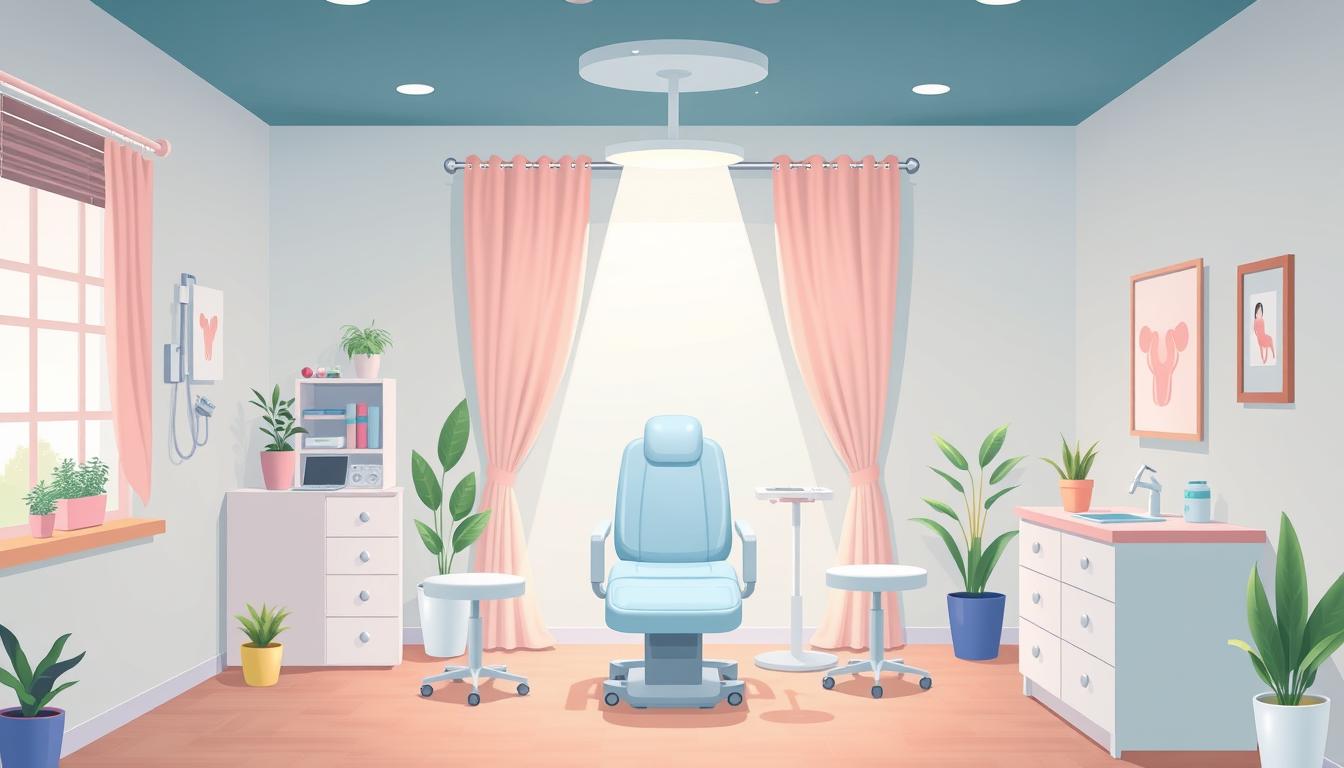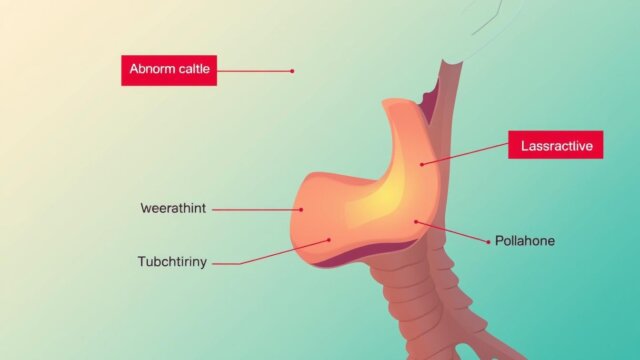FTC disclaimer: This post may contains affiliate links and we will be compensated if you click on a link and make a purchase.
Did you know cervical cancer screening is a big win in the US? It helps find changes in cervical cells before they turn into cancer. The main goal is to catch these changes early when they can still be treated.
Different screening methods include the HPV test, Pap test, and HPV/Pap cotest. It’s very important to get screened regularly. This is because cervical cancer is easier to treat if caught early.
Key Takeaways
- Cervical cancer screening aims to detect precancerous cell changes before they develop into cancer.
- Screening can be done through HPV tests, Pap tests, and HPV/Pap cotesting.
- Regular screening is essential, as early-stage cervical cancer is usually more treatable.
- Screening recommendations vary by age and health history, with guidelines from organizations like USPSTF and ACS.
- Screening locations include doctors’ offices, clinics, and community health centers.
What is Cervical Cancer Screening?
Purpose and Methods of Screening
Cervical cancer screening is a key health check. It looks for changes in cervical cells that could lead to cancer. This process uses three main tests: the HPV test, the Pap test, and the HPV/Pap cotest. These tests check for high-risk HPV types and abnormal cervical cells.
Early detection is key. It lets doctors treat problems before they turn into cancer. Regular screenings catch changes early, when treatment works best.
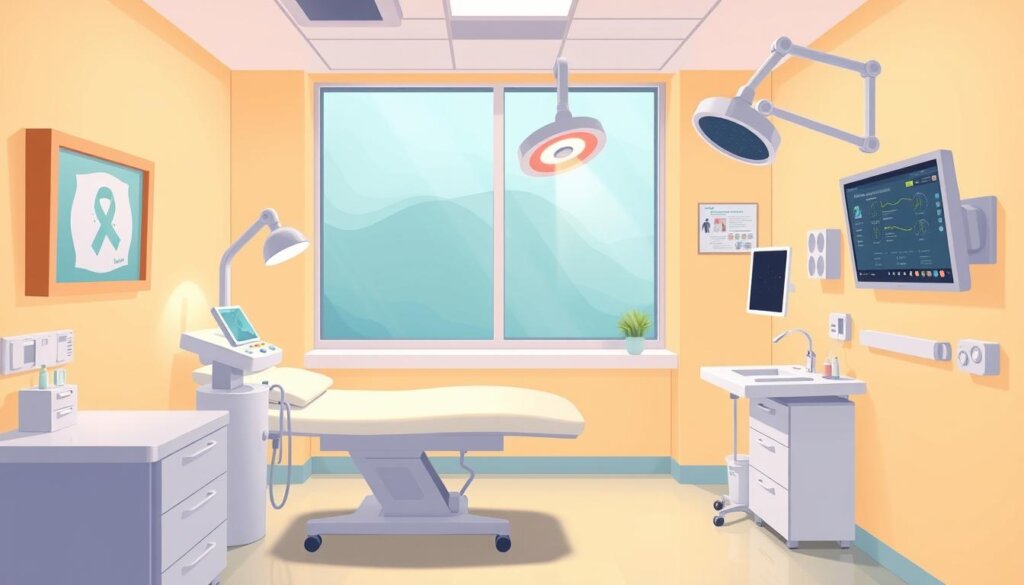
“Cervical cancer screening is a vital health check that aims to detect precancerous cervical cell changes before they develop into cervical cancer.”
Screenings can find problems early, helping with treatment and health. By getting screened often, people can help keep themselves healthy.
When to Get Screened for Cervical Cancer
Groups like the United States Preventive Services Task Force (USPSTF) and the American Cancer Society (ACS) set guidelines. These guidelines tell you when to get screened based on your age.
Women aged 21 to 29 should get a Pap test every 3 years. For those 30 to 65, you can choose from several options. You can get an HPV test every 5 years, a Pap test every 3 years, or both tests every 5 years. Women over 65 might not need screening if they’ve been screened enough before and are not at high risk.
Some people might need to be screened more often. This includes those with a history of abnormal results or a weakened immune system. In these cases, more frequent tests are suggested.
It’s important to see your gynecologist or Ob-Gyn regularly. This is true for all ages, not just for cervical cancer screening.
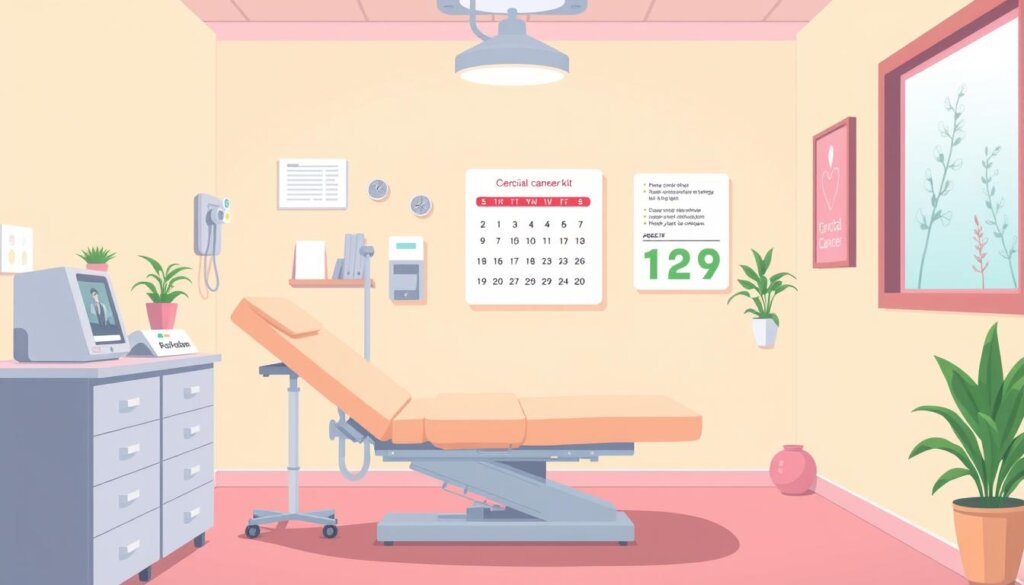
“Regular cervical cancer screening has been shown to prevent cervical cancers and save lives. Early detection of cervical cancer greatly improves the chances of successful treatment.”
By following the recommended screening schedule, you can protect your health. You can catch any problems early.
Cervical Cancer Screening
Screening Tests and Protocols
Cervical cancer screening is key to catching the disease early. The main tests are the HPV test and the Pap test, also known as the Pap smear. The HPV test looks for high-risk HPV types that can lead to cervical cancer. The Pap test checks for abnormal cells that might show precancerous lesions.
Studies show that using both the HPV test and the Pap test together is better. This method finds more cervical problems than the Pap test alone. Doctors might use different plans to handle abnormal results, like doing the test again or sending the patient for a colposcopy.
Screening Test | Purpose |
|---|---|
HPV Test | Checks for high-risk HPV types that can cause cervical cancer |
Pap Test | Collects cervical cells to check for abnormal changes |
HPV/Pap Cotest | Combines the HPV test and Pap test for better detection of cervical abnormalities |
Following the right screening plans is important. It helps keep the benefits of screening while avoiding false negatives. Regular screening can find cervical cancer early, making treatment more effective.

“The World Health Organization (WHO) states that cervical cancer is almost entirely preventable through the use of vaccination, screening, and treatment of precancerous lesions.”
Timing and Age for Screening
Cervical cancer screening depends on a woman’s age. Women aged 21-29 should get a Pap test every 3 years. For those 30-65, they can choose from several options: an HPV test every 5 years, a Pap test every 3 years, or an HPV/Pap co-test every 5 years. Women under 21 and over 65 with no high-risk factors usually don’t need screening.
The American Cancer Society (ACS) suggests primary high-risk human papillomavirus (hrHPV) testing for those aged 25–65 and every five years for those aged 25–29.
Screening guidelines aim to find cancer early without too much testing. They consider age, risk, and past screenings for a personalized approach.
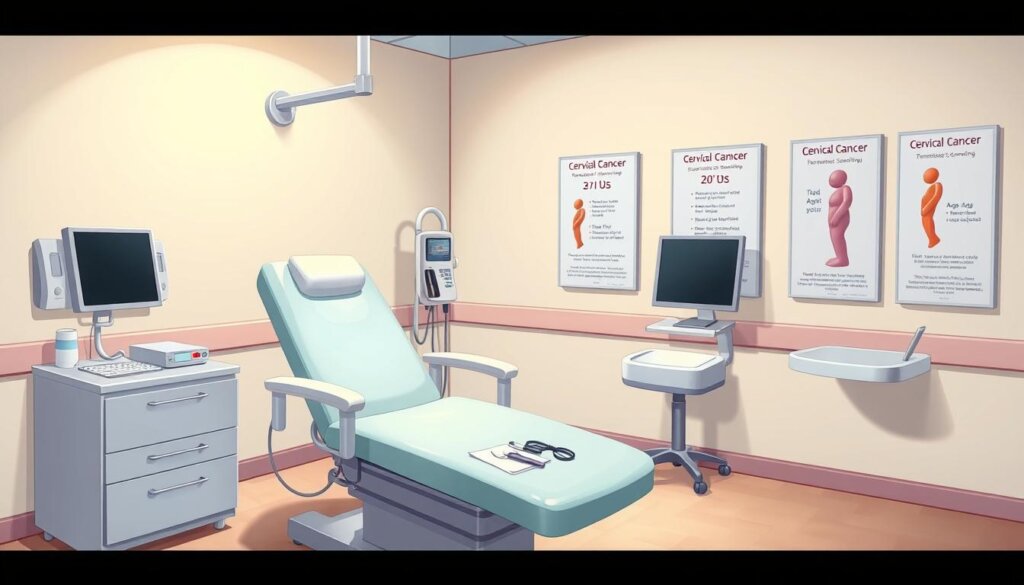
Colon cancer testing starts at 21 to 29 for those at high risk. Breast cancer testing also starts at 21 to 29 for high-risk women.
Cancer Type | Screening Recommendations by Age |
|---|---|
Cervical Cancer |
|
Colon Cancer |
|
Breast Cancer |
|
Following cervical cancer screening guidelines helps keep you healthy. The age and interval recommendations are designed to be effective.
Screening Recommendations
Cervical cancer screening is key, as the USPSTF and ACS say. They want to help and not harm. This is why they have guidelines.
Women 21 to 29 should get a Pap test every 3 years. For those 30 to 65, you can choose from a few options. You can get an HPV test every 5 years, a Pap test every 3 years, or both together every 5 years.
Women over 65 who have been screened before and are not at high risk might not need screening anymore.
The ACS and ACOG also agree on these guidelines. They say regular screening is key for catching cancer early, and their advice is based on extensive research.
“Screening recommendations for cervical cancer aim to maximize the benefits of early detection and minimize the potential harms associated with unnecessary procedures.”
Following these guidelines is very important for your cervical health. It helps prevent cervical cancer. Women can get the right care by sticking to the USPSTF, ACS, and ACOG advice.
People with certain risks, like abnormal Pap tests or HPV, might need more tests. It’s best to talk to a doctor to figure out what’s right for you.
Risks and Limitations
Cervical cancer screening has saved many lives. But, it comes with risks and limits. Cervical cancer screening risks include false-positive and false-negative results. These can cause unnecessary tests or delays in getting medical help.
False-positive results can make people very anxious. They might lead to more tests like colposcopy and biopsy. False-negative results, on the other hand, can let cancer go undetected for too long.
Screening can also find problems that won’t cause harm, which can lead to unnecessary treatments. Such overdiagnosis can be hard on patients physically, emotionally, and financially.
Before screening, talk to your doctor about the risks and benefits. Together, you can decide if the benefits outweigh the risks.
“The accuracy of a screening test is measured as a trade-off between sensitivity and specificity.”
Knowing the limits of screening helps people make better health choices. It ensures they get the right care for their needs.
Where to Get Screened
Cervical cancer screening tests, like the Pap test and HPV test, are done during a routine pelvic exam. You can get these screenings from many places, such as doctors’ offices, clinics, and community health centers. Many women get screened by their OB/GYN or primary care doctor.
If you don’t have a regular doctor, you can find a clinic for screenings. Call your state or local health department, the National Breast and Cervical Cancer Early Detection Program, Planned Parenthood, or the National Cancer Institute’s Cancer Information Service. They can help you find low-cost or free screenings in your area.
Screening Test | Recommended Age | Frequency |
|---|---|---|
Pap Test | Ages 21-65 | Every 3 years or with HPV test every 5 years |
HPV Test | Ages 25-65 | Every 5 years or with Pap test every 5 years |
Pap Test (limited HPV access) | Ages 21-65 | Every 3 years |
Remember, getting regular cervical cancer screenings is key for early detection and prevention. Talk to your healthcare provider to ensure you get the right screenings at the right time.
“Cervical cancer screening is a critical preventive health service that can save lives. Make it a priority to get regularly screened, and encourage your loved ones to do the same.”
By being proactive and using the available screening services, you can protect your health for the long term.
The Screening Process
What to Expect During a Screening
Cervical cancer screening tests are done during a pelvic exam. This exam only takes a few minutes. A speculum opens the vagina to see the cervix.
A small brush or spatula gets cells from the cervix. These cells are tested for HPV and abnormal changes.
Some doctors let you self-collect the cervical sample, which goes to a lab for testing. People with obesity might find it hard to get a good sample because they visualize the cervix.
“Cervical cancer screening tests are typically performed during a pelvic exam, which takes only a few minutes.”
The goal of screening is to find precancerous changes or early cervical cancer. This way, treatment can start early. Knowing what happens during a screening helps you take care of your cervical health.
Cervical Cancer Screening Trends
Cervical cancer screening has helped lower rates of the disease and deaths. Yet, there are big gaps in screening across the U.S.. Non-Hispanic White women lead with a 75.7% screening rate. Non-Hispanic Black women follow at 71.6%, and Hispanic women at 67.9%.
Women making less than 200% of the federal poverty level screen less, at 63.3%. Those making 200% or more screen at 76.0%.
Education also affects screening rates. Women with more than a high school education screen more, at 77.2%, compared to those with less than a high school education, at 58.4%.
The goal for 2030 is to reach 84.3% screening rates for women aged 21 to 65. However, the rate was only 72.4% in 2021.
Screening rates have been falling, which is a concern. From 1999 to 2019, screening for women aged 65 and older dropped by 55.3%. This means fewer women are getting tested.
Colposcopy and cervical procedure use rates fell by 43.2% and 64.4%, respectively.
Metric | Rate |
|---|---|
Women aged 21-65 up-to-date with screening (2021) | 72.4% (95% CI: 71.2 – 73.5%) |
Women aged 65+ receiving screening (1999) | 18.9% (2.9 million) |
Women aged 65+ receiving screening (2019) | 8.5% (1.3 million) |
Medicare spending on cervical cancer screening (2019) | $83.5 million |
Women aged 80+ receiving screening (2019) | 3% ($7.4 million) |
We need to keep working to make sure all women get screened for cervical cancer. This is especially true for those in underserved groups.
Conclusion
Cervical cancer screening is key to finding problems early. It can spot changes before they turn into cancer. This early detection can greatly lower the risk of getting and dying from this preventable cancer.
Thanks to screening, fewer women are getting cervical cancer and dying from it. But some women still don’t get screened as they should. It’s important to make sure all women get screened, especially those who are hard to reach.
Screening programs have been shown to cut down on cervical cancer cases and deaths. Yet, we need to keep working to make screening more important and get more people involved. We can aim to wipe out cervical cancer by 2130 by focusing on early detection and prevention.
Cervical cancer is something we can prevent, and screening is the best way to catch problems early. By encouraging women to value their cervical cancer screening importance and join screening programs, we can keep reducing this disease’s impact. This way, we can look forward to a healthier future for everyone.
FAQ
What is the purpose of cervical cancer screening?
Cervical cancer screening aims to find early signs of cancer. It looks for cell changes that could turn into cancer. This way, doctors can treat them early.
What are the main methods of cervical cancer screening?
There are three main screening methods: the HPV test, the Pap test, and the HPV/Pap contest, which uses both tests together.
How often should I get screened for cervical cancer?
Screening frequency depends on your age. Women 21-29 should get a Pap test every 3 years. Women 30-65 can choose from several options. These include an HPV test every 5 years, a Pap test every 3 years, or the HPV/Pap cotest every 5 years.
What are the potential harms of cervical cancer screening?
Screening can lead to false positives and unnecessary tests. It can also miss cancer early. Sometimes, it finds things that won’t cause problems, leading to treatment that’s not needed.
Where can I get screened for cervical cancer?
You can get screened at doctors’ offices, clinics, and community health centers. Many get tested by their ob/gyn or primary care doctor. If you don’t have a doctor, you can find a clinic that offers screening.
What can I expect during a cervical cancer screening?
Screening is quick, taking just a few minutes. It’s done during a pelvic exam. A speculum opens the vagina, and a small brush or spatula collects cells from the cervix for testing.
Are there any groups that are less likely to be screened for cervical cancer?
Yes, some groups are less likely to get screened. Women without health insurance or a regular doctor are at higher risk. The South has the highest rates of cervical cancer and inadequate screening.
